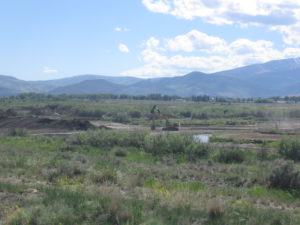I grew up with the largest Superfund site in the US in my backyard. I grew up with the tangle of emotions that claim evoked.  The society around me spends a lot of energy celebrating the best and biggest of everything and part of me like being able to say we had the biggest Superfund site in the country. Mostly though, I was angry and ashamed about what we Montanans had done to a place we still like to call the last best place. I was also scared because no one really knew how well Milltown Dam could with stand a big flood event if it broke, things could have gotten much worse.
The society around me spends a lot of energy celebrating the best and biggest of everything and part of me like being able to say we had the biggest Superfund site in the country. Mostly though, I was angry and ashamed about what we Montanans had done to a place we still like to call the last best place. I was also scared because no one really knew how well Milltown Dam could with stand a big flood event if it broke, things could have gotten much worse.
For those who don’t know, the largest Superfund site in the US stretches from Butte, MT, to just east of Missoula, MT, a 140 mile stretch of the Clark Fork River. Butte, once the richest hill on earth, was the site of extensive mining operations. In the late 1800s, tailings and other mine waste began accumulating in Silver Bow Creek. In 1908, a hundred year flood event carried these mine wastes, laden with heavy metals, across the flood plain around both Silver Bow Creek and the upper Clark Fork River until the sediments were finally stopped by the newly constructed Milltown Dam. In some places along the floodplain the toxic sediment, called slickens, was 6 to 8 feet deeps. This contamination resulted in the virtual elimination of aquatic life in Silver Bow Creek and killed much of the vegetation on the flood plain, leaving highly contaminated areas where plants were unable to grow. However, it wasn’t until 1981 when arsenic was discovered in the aquifer near the Milltown Reservoir from the mining waste that had accumulated behind the dam and human safety from toxic drinking water was threatened that people became concerned about the contamination. A few years later, the Environmental Protection Agency (EPA) declared the upper Clark Fork River corridor a federal Superfund site. It took years of negotiations and planning, but cleanup operations are underway, since the 2006-2009 removal of Milltown Dam and the sediments collected behind it.
I grew up with the country’s largest Superfund site in my backyard and I am fiercely proud of the work that has been done and is in progress to repair the damage we have done to the Clark Fork River. At the same time, this is restoration writ large. This is restoration that looks more like destruction at first, restoration carried out with heavy machinery, so many trucks that it isn’t always possible, as it wasn’t the day we visited, to tour the site currently being worked on.
I know that the damage done to this stretch of the Clark Fork is extensive enough and dangerous enough that this large scale restoration is the only option. I also know that there has been community involvement in the planning process and, from personal experience, in the later stages of restoration, things like revegetation and pulling weeds so the young native plants have a chance to establish themselves. Despite my pride that work is being done and my participation in a tiny piece of the restoration, I want more.
I want all the rafters, tubers, kayakers and cliff jumpers that a hot day in summer brings out to the river in swarms to talk about the history of the river they are enjoying. I want to see them giving back to the river, participating in the reciprocal relationships David Abram so eloquently describes as essential as breath in his essay “Reciprocity and the Salmon: water-borne reflections from the northwest coats” [1]: “The gift of the mountains and the forests to the vast ocean, and later, the return of that gift, now offered from the sea to the land, to these forests and mountain valleys, which ensures that the gift will be reborn afresh from a clump of luminous eggs buried beneath a layer of pebbles, so that it can be given, once again, to the salty depths of the sea.” I want the restoration to be a community effort. I want this restoration work to restore the relationship of my community with the river that makes our home what it is.
I crave a new definition of restoration that goes beyond the technical aspects of “the process of renewing and maintaining ecosystem health,” which is the basic definition of ecological restoration put forth by the Society for Ecological Restoration (SER) in 1995 and which is still the primary focus of most restoration projects. I want the question “What sort of relationship with nature [do we want this] restoration [effort] to signify and encourage?” asked during the planning process of every restoration project. I want good ecological restoration[2] to be measured in part by how well a project incorporates community involvement and teaches people to value their environments enough to not let the same destruction take place again in the future. The work of restoration should be the work of creating signs for ourselves in our hearts that read “Never Again.”